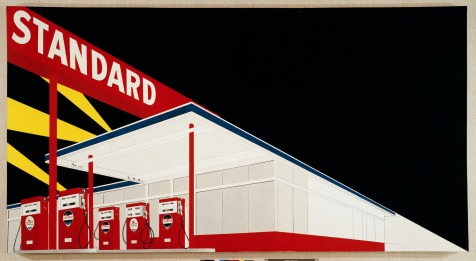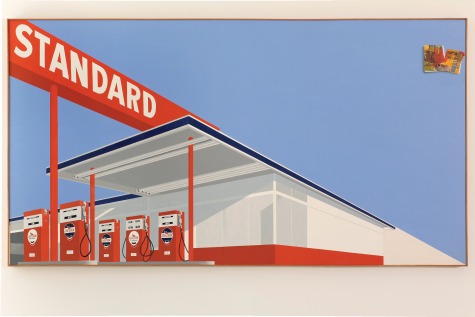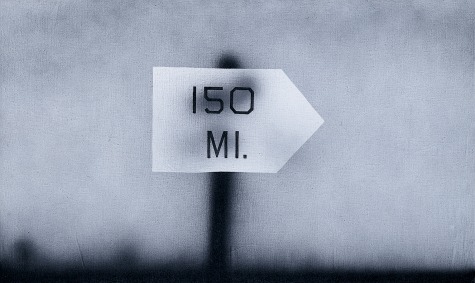
Ed Ruscha, Standard Station, Amarillo, Texas, 1963, Oil on canvas, 65 x 124 inches, Collection Hood Museum of Art, Dartmouth College, Hanover, NH; gift of James Meeker, Class of 1958, in memory of Lee English, Class of 1958, scholar, poet, athlete and friend to all
Hanging above the hand-me-down loveseat in my college apartment was a print of Edward Hopper’s 1940 painting Gas that I’d bought at the poster sale in our student life center. I liked Hopper at the time because of the romantic narratives that one could spin out from his pictures, and while I can now hardly stomach a Hopper painting, I always feel pangs of a youthful, naïve wanderlust when looking at them.
Each time I’ve gone to the Modern Art Museum of Fort Worth, I’ve regarded a painting by Ed Ruscha called Standard Station with Ten Cent Western Being Torn in Half (1964), that recalls Hopper’s Gas with an exacting renegade spirit, pushing Hopperian solitude onto a plane perhaps not peopled, but definitely traveled. It’s the open road, that place that Hopper’s doleful figures always, Keatsian urn style, seem to pine for: that way–off, somewhere, other place. Ruscha’s gas station, with its linear certitude and monolithic, angled view, is all virile possibility without any of Hopper’s malaise-filled second guessing and infinite inertia.
Ed Ruscha left Oklahoma City in 1956 in a Ford sedan and headed not east to New York with all its heavily wrought paint, but West to Los Angeles, a new wide-open art terrain. On that trip, Ruscha began what would become a lifelong fascination with the open road. That fascination is chronicled in the exhibition Road Tested at the Modern Art Museum of Fort Worth. Curated by Michael Auping, it features many of Ruscha’s road-inspired paintings, prints, photographs and artist books. In the first room of the show are the road maps and meticulous travel logs that Ruscha kept on his trek to LA back in ’56, but also the map he used on a hitchhiking trip he took when he was fourteen. These serve as a kind of authentication stamp on the artist’s body of work, proving that Ruscha’s love of the road was bonafide and deep-rooted. The maps and notebooks also indicate the genesis of many of his ideas for future work.

Ed Ruscha, Standard Station with Ten-Cent Western Being Torn in Half, 1964, Oil on canvas, 65 x 121 1/2 inches, Private Collection
The artist’s compulsion to catalogue is clear from the beginning of the show. The exhibition shows many of the photographs Ruscha took along the road on various travels, primarily gas stations and middle-of-nowhere watering holes for the weary road traveler. Most of these shots are taken with the same perspective as his famous Standard gas station paintings—that angled, vanishing point view that both monumentalizes the subject and diminishes it. Of these shots, none are particularly compelling in their own right, but the quantity of collected images of so many disparate but similar places is what is so forceful in Ruscha’s photographs. That there are so many doppelganger road stops to capture is the point, and one that finds its corollary in a myriad of other uniquely American themes: fast food chains, suburban housing, big-box stores, used car lots. Fifty-odd years ago, Ed Ruscha was describing the shape of America’s landscape as it was becoming what it has become.
There are two large Standard gas paintings here, one that Ruscha did in 1963 that shows searchlights scoping a black sky, and another, done in 1964, with exactly the same composition, minus the lights and with a blue sky and a floating comic book. The former, Standard Station, Amarillo, Texas is more powerful, I think, in reproductions and glossy book pages. Here, in real life, it seems flat, the paint not quite solid enough and too full of inconsistencies to make the picture pop with the vigor the composition warrants. The picture seems sophomoric.
But he gets it right in Standard Station with Ten Cent Western Being Torn in Half done a year later. He’s gotten the paint to achieve those comic book, advertising solids that give the image the force of all its diagonals and hard edges. And he has, of course, added the surreal little detail of the ten-cent western magazine in the upper right corner. The picture is accented with that prop of travel, a magazine torn in half, which signifies an experience that happened outside of the frame of the picture. The addition of the magazine makes the painting not so much about the gas station as everything that happened before and after it. In that way, the picture has a narrative quality.
Much of Ruscha’s work plays the same trick, especially his word paintings that are visual/verbal puzzles that make for a lot of in-gallery head scratching. Half the fun of looking at the artist’s work here is listening to other museum goers try and suss out his picture riddles. Like the phrase “Ice Princess” laid over a nighttime aerial view of a grid of streets, with car lights glowing like grounded stars. Is the city below, presumably LA, the ice princess? Has the artist been jilted by the place? Someone else? Doesn’t matter. The painting builds references and relationships through the meanings of the words, making for other, mental images to unfold in the viewer. The painting serves as a jumping off point to a whole internal, conjured storyboard.
Ruscha’s Hollywood paintings and prints are some of the most interesting, I think. Nice to look at, and versatile within their constraint, these images encounter, over and over, the personality of a place by reducing it, or summing it up, with as little information as possible. Just as the actual Hollywood sign up on the hill serves as an indicator of reaching a promised land, Ruscha’s flattened, otherworldly landscapes with the famous word deflate and squelch the bravado of the icon while keeping it mysterious.
Ruscha’s artist books on display are conceptually driven little logs of work and observation that capture best his relationship with the road. Every Building on Sunset Strip, 1966, for example, is an accordion book of pictures of just that—every building on Sunset Strip, on both sides of the street—with each building‘s photo adjoined to its neighbor. They relate the artist’s engagement with the city of Los Angeles—his scrutinizing in-it-ness, as if he could count every hair on its head, so to speak.
Like so much of the work here, these calculating little books belie Ruscha’s affection, not just for the road, but for all of its accoutrements. There is a pointed romance evident in his art, a Hopperian undoing that secures the artist’s images as icons of high-brow American nostalgia. Ruscha’s work here is tenderness wrapped up as information.
![]()
Lucia Simek is an artist and writer living in Dallas. She co-founded the culture site Renegade Bus in 2009, and is a frequent contributor to D Magazine‘s arts blog FrontRow.




